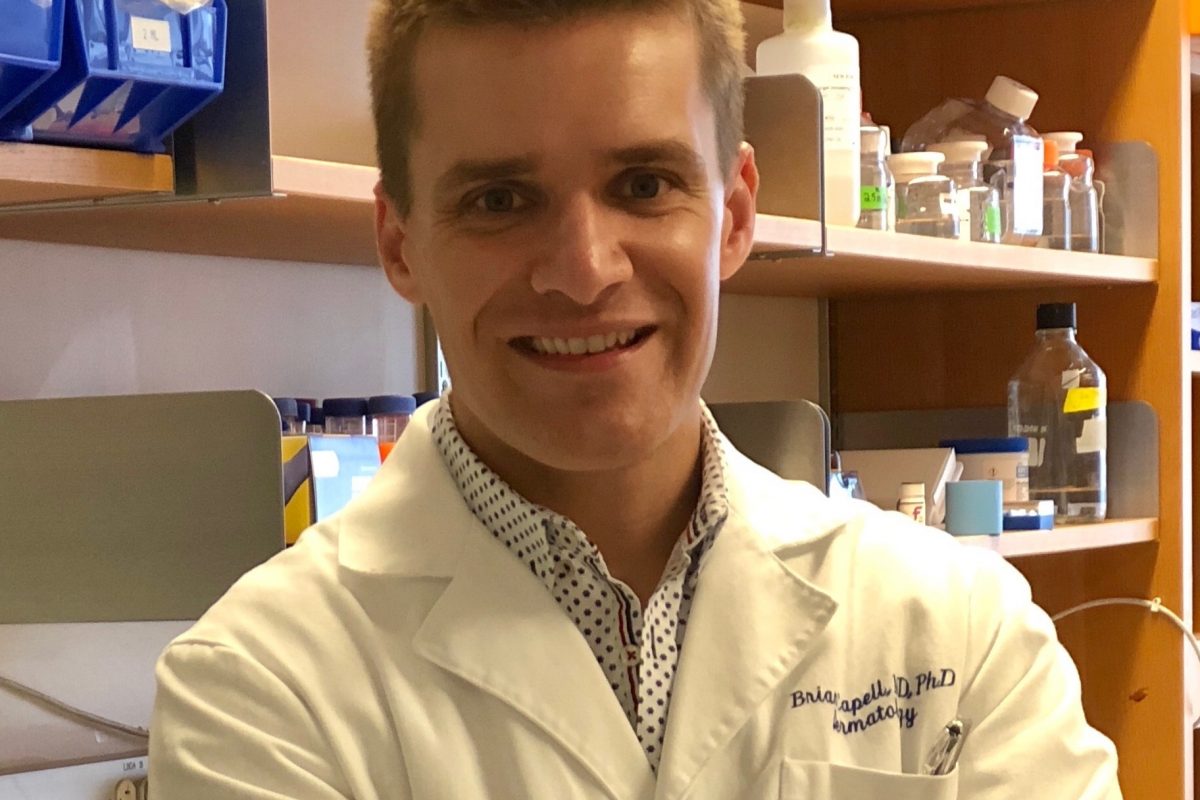Targeted Protein Degradation
Approximately 75% of the proteome is considered undruggable by traditional small molecule inhibition approaches. As an LLS postdoctoral fellow at Yale, I contributed to the development and application of Proteolysis Targeting Chimera (PROTACs) – heterobifunctional small molecules which recruit an E3 ligase to a protein target, resulting in target ubiquitination and subsequent degradation via the proteasome. This enables small molecule induced degradation of disease relevant proteins in native systems including in vivo. One of my contributions was to expand this approach to transmembrane proteins (specifically receptor tyrosine kinases) which are not endogenously degraded via the proteasome but can be degraded in this manner under small molecule control. The PROTAC approach has also been applied to crucial targets (BCR-Abl and FLT-3 ITD) in hematological malignancies demonstrating the power of the PROTAC approach for drug discovery and revealing previously unknown scaffolding roles of these kinases.
– Proteolysis-Targeting Chimeras as Therapeutics and Tools for Biological Discovery, G.M. Burslem and C.M. Crews, Cell, 2020, 181, 102. PMCID: PMC7319047
– Targeting BCR-ABL1 in Chronic Myeloid Leukemia by PROTAC-mediated Targeted Protein Degradation, G.M. Burslem, A. Reister-Schultz, D.P. Bondeson, C. Eide, S. Savage, B. Druker and C.M. Crews, Cancer Research, 2019, 79. 4744. PMCID: PMC6893872
– Enhancing Antiproliferative Activity and Selectivity of a FLT-3 Inhibitor by Proteolysis Targeting Chimera Conversion, G.M. Burslem, J. Song, X. Chen, J. Hines and C.M. Crews, J. Am. Chem. Soc., 2018, 140, 16428. PMID: 30427680
– The Advantages of Targeted Protein Degradation over Inhibition: an RTK Case Study, G.M. Burslem, B.E. Smith, A. Lai, S. Jaime-Figueroa, D. McQuaid, D.P. Bondeson, M. Toure, H. Dong, Y. Qian, J. Wang, A.P. Crew, J. Hines and C. M. Crews, Cell Chemical Biology, 2018, 25, 67. PMCID: PMC5777153
HIF-1α/p300 Inhibition
Mammalian cells have developed an elaborate pathway for oxygen sensing with a key player in this pathway being hypoxia inducible factor 1α (HIF-1α). Under hypoxic conditions, HIF-1α accumulates, heterodimerizes and translocated to the nucleus where it forms a protein-protein interaction with p300. This complex is transcriptionally active resulting in the hypoxic response and resupply of oxygen to the hypoxic tissue. This pathway is crucial for growth and development but is also exploited by solid tumors to enable growth to continue after exhaustion of their oxygen supply. As a graduate student, I focused on elucidating the molecular recognition between HIF-1α and p300 using biophysical and biochemical approaches before applying that knowledge to develop the first biophysically characterized inhibitors of this protein-protein interaction. Furthermore, this project led to the identification of novel peptide and protein aptamer inhibitors of the HIF-1α/p300 interaction via phage display and a novel class of chemical probes which incorporates both natural and unnatural recognition elements to provide enhanced selectivity and potency.
– Hypoxia Inducible Factor as a Model for Studying Inhibition of Protein-Protein Interactions, G.M. Burslem, H.F. Kyle, A.S. Nelson, T.A. Edwards, A.J. Wilson, Chemical Science, 2017, 8, 4188. PMCID: PMC5576430
– Towards “Bionic” Proteins: Replacement of Continuous Sequences from HIF-1α with Proteomimetics to Create Functional p300 Binding HIF-1α Mimics, G.M. Burslem, H.F. Kyle, A. L. Breeze, T.A. Edwards, S.L. Warriner, A. S. Nelson and A.J. Wilson, Chem. Commun., 2016, 52, 5421. PMCID: PMC4843846
– Small molecule proteomimetic inhibitors of the HIF-1α/p300 protein-protein interaction, G.M. Burslem, H. Kyle, A. Breeze, T.A. Edwards, A. Nelson, S.L. Warriner and A.J. Wilson, ChemBioChem, 2014, 15, 1083. PMCID: PMC4159589
– Exploration of the HIF-1α/p300 binding interface using peptide and adhiron phage display technologies to locate binding hot-spots for inhibitor development, H. F. Kyle, K. F. Wickson, J. Stott, G. M. Burslem, A. L. Breeze, D. C. Tomlinson, S. L. Warriner, A. Nelson, A. J. Wilson and T. A. Edwards, Mol. Biosyst., 2015, 11, 2738. PMID: 26135796
Modulating Protein-Protein Interactions
There are an estimated 650,000 pairwise protein-protein interactions in the human interactome and these interactions are implicated in all biological pathways. As such, the ability to modulate protein-protein interactions with chemical probes can provide unique insights in the functional roles of proteins and their binding partners. Over my career I have developed chemical biology approaches to both inhibit and induce protein-protein interactions as tool compounds and therapeutic approaches. An attractive approach to the inhibition of protein-protein interactions is to develop molecules which mimic a portion of one of protein binding partners and thus preferentially occupy the binding site on the other. Peptides are capable of doing this but must pay a significant entropic penalty to adopt the required conformation due to their inherent flexibility. One approach to combat this is to pre-organize the peptide into the desired conformation by chemically “stapling” it. Another approach is to develop small molecule mimetics capable of recapitulating the recognition elements of a protein/peptide but with less conformational flexibility. I have applied both of these techniques to generate inhibitors of a variety of protein-protein interactions including p53/hDM2, Bcl-XL/BID and RNase S-peptide/S-protein. Furthermore, protein-protein interactions can be induced by small molecules known as molecular glues which we have employed to stabilize interactions between Cereblon and IKZF1. We have also demonstrated the ability to induce protein-protein interactions between various proteins using heterobifunctional compounds.
– Double Quick, Double “Click” Reversible Peptide “Stapling”, C.M. Grison, G.M. Burslem, J.A. Miles, L. Pilsl, D.J. Yeo, S.L. Warriner, M. E. Webb and A. J. Wilson, Chemical Science, 2017, 8, 5166. PMCID: PMC5618791
– Synthesis of Highly Functionalized Oligobenzamide Proteomimetic Foldamers by Late-Stage Introduction of Sensitive Groups, G.M. Burslem, H.F. Kyle, P. Prabhakaran, A. L. Breeze, T.A. Edwards, S.L. Warriner, A. Nelson and A.J. Wilson, Org. Biomol. Chem. 2016, 14, 3782. PMCID: PMC4839272
– Efficient Synthesis of Immunomodulatory Drug Analogues Enables Exploration of Structure Degradation Relationships. G.M. Burslem*, P. Ottis, S. Jaime-Figueroa, A. Morgan, P.M. Cromm, M. Toure and C.M. Crews*, ChemMedChem, 2018, 12, 1508 (*Co-corresponding authors). PMCID: PMC6291207
– Lessons on Selective Degradation with a Promiscuous Warhead: Informing PROTAC Design, D.P. Bondeson, B.E. Smith, G.M. Burslem, A.D. Buhimschi, J. Hines, S. Jaime-Figueroa, J. Wang, B. Hamman, A. Ishchenko, C.M. Crews, Cell Chemical Biology, 2018, 25, 78. PMCID: PMC5777153
Epigenetic Chemical Biology
Epigenetic drug discovery provides a wealth of opportunities for the discovery of new therapeutics but has been hampered by low hit rates, frequent identification of false-positives, and poor synthetic tractability. Since establishing my laboratory at the University of Pennsylvania, we have endeavored to remedy the low hit rate in drug discovery efforts against epigenetic targets, by careful chemo-informatic analysis of active compounds and screening libraries. We have used the information gathered in these analysis to inform the design and synthesis of privileged compound collections for epigenetic chemical biology and probe discovery.
– Photochemical Synthesis of an Epigenetic Focused Tetrahydroquinoline Library, A.I. Green and G.M. Burslem, RSC Medicinal Chemistry, 2021, DOI: 10.1039/D1MD00193K
– Focused Libraries for Epigenetic Drug Discovery: The Importance of Isosteres, A.I. Green and G.M. Burslem, J. Med. Chem, 2021, 64, 7231-7240. PMID: 34042449
– Advances and Opportunities in Epigenetic Chemical Biology, J. Beyer, N. Raniszewski and G.M. Burslem, ChemBioChem, 2021, 22, 17-42. PMID: 32786101









